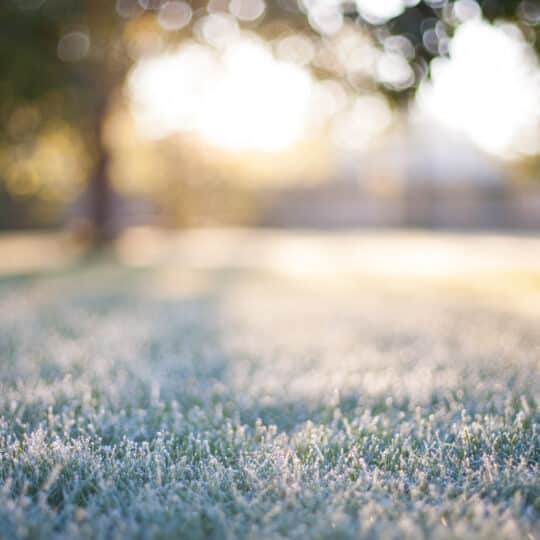4 Effects of Frost on Grass
Plus 5 Ways to Prevent Extensive Damage

Throughout the winter, a frost-covered landscape is both a norm and a concern for gardeners. While it may create a picturesque wonderland scene, it can also pose risks to delicate plants and grass. Learn how frost forms, its effects on grass, and what you can do to help prevent it from damaging your landscape.
How Frost Forms
Frost usually forms in the early morning hours. This is also the time you’d notice dew during any other season. But in the winter, temperatures drop below freezing, turning water vapor in the air into ice on surfaces such as grass blades, leaves, and windshields. Several factors influence frost formation:
- Clear skies. Earth’s surface radiates heat quickly, resulting in lower overnight temperatures.
- Radiative cooling. As the sun sets, the earth’s surface loses heat through radiation, causing temperatures to drop.
- Calm conditions. Warm and cold air are less likely to mix, allowing cold air to settle near the ground.
- Low humidity. Dry air cools even faster, facilitating frost formation.
There are two main types of frost:
- Radiation / Ground frost: occurs on clear, calm nights when the ground loses heat rapidly through radiation, causing the surface to freeze.
- Advection frost. Cold air moves over a warmer surface, causing the temperature to drop below freezing and form frost.
Both of these types of frost can leave your lawn with a wintery aesthetic that could lead to potential problems under certain conditions.
Effects of Frost on Grass
Frost can have detrimental effects on grass, especially if it persists or is repeatedly stepped on. Some common effects include:
- Cell damage. When ice forms within plant cells it can rupture cell walls leading to tissue damage. The constant freezing and thawing of grass blades can also damage cells.
- Discoloration and wilting. You may notice your grass turn brown over the winter. This could happen for a few reasons, including normal dormancy. However, frost-damaged grass may also turn brown and appear limp, especially after being trampled by foot traffic.
- Stunted growth. Grass usually goes dormant during the winter and stops growing. However, prolonged exposure to frost can also affect its overall health.
- Increased susceptibility to disease. Frosty grass is more delicate and the blades are more prone to break. This weakens its defences and compromises its ability to heal, leaving it open to disease and pests.
Preventing Frost Damage
While you can’t control the climate and environmental factors leading to frost, you can help protect your grass from the resulting damage. Here are a few ways to help ensure your lawn and plants are ready to withstand the winter weather.
- Mow. Taller grass blades are more likely to break or become matted underneath a layer of ice and snow. This is why it’s important to keep your grass mowed at an appropriate height. Before the first frost, adjust your mower height to gradually cut less grass before you stop mowing. You still want it tall enough to promote air circulation through the blades but short enough to prevent moisture from accumulating, reducing the risk of frost damage.
- Water. Make sure your lawn is well watered and properly drained before the first frost. This can help raise soil temperature, reducing the likelihood of frost damage.
- Mulch. Apply a layer of organic mulch, such as straw or shredded leaves, around vulnerable areas to insulate the soil and minimize heat loss.
- Protect. Cover delicate plants and young trees with thinner branches with burlap to help provide temporary protection from frost, snow, and ice.
- Stay off. Frosted grass can easily break under foot traffic. You’re more likely to mat down a path through your lawn if you walk on dormant grass that’s slow to bounce back. Try to stay off your lawn, at least until the frost has thawed.
Revitalizing a Damaged Lawn
A well maintained lawn is more likely to bounce back after a frosty winter. However, if your lawn is looking a little weak this spring, there’s still a way to help bring it back to life. Contact Green Image Lawn Care to help restore your grass to its original lushness. Once there’s no more threat of frost, we can help renovate your lawn to prevent disease and weeds. Not only will you enjoy a healthy-looking yard, but it will be more equipped to survive the next round of freezing temperatures.